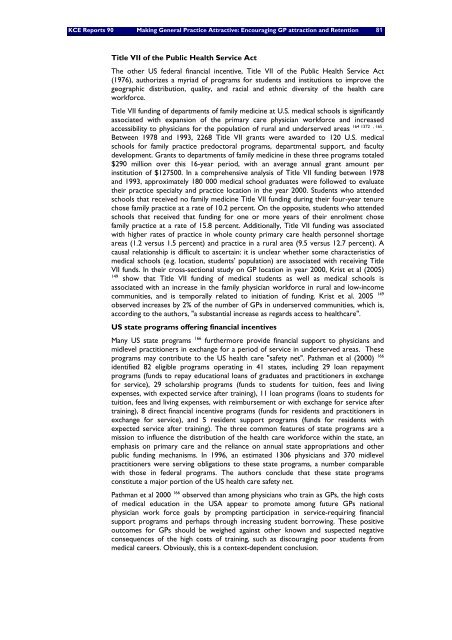Download the report (150 p.) - KCE
Download the report (150 p.) - KCE
Download the report (150 p.) - KCE
You also want an ePaper? Increase the reach of your titles
YUMPU automatically turns print PDFs into web optimized ePapers that Google loves.
<strong>KCE</strong> Reports 90 Making General Practice Attractive: Encouraging GP attraction and Retention 81<br />
Title VII of <strong>the</strong> Public Health Service Act<br />
The o<strong>the</strong>r US federal financial incentive, Title VII of <strong>the</strong> Public Health Service Act<br />
(1976), authorizes a myriad of programs for students and institutions to improve <strong>the</strong><br />
geographic distribution, quality, and racial and ethnic diversity of <strong>the</strong> health care<br />
workforce.<br />
Title VII funding of departments of family medicine at U.S. medical schools is significantly<br />
associated with expansion of <strong>the</strong> primary care physician workforce and increased<br />
accessibility to physicians for <strong>the</strong> population of rural and underserved areas 164 1372 , 165 .<br />
Between 1978 and 1993, 2268 Title VII grants were awarded to 120 U.S. medical<br />
schools for family practice predoctoral programs, departmental support, and faculty<br />
development. Grants to departments of family medicine in <strong>the</strong>se three programs totaled<br />
$290 million over this 16-year period, with an average annual grant amount per<br />
institution of $127500. In a comprehensive analysis of Title VII funding between 1978<br />
and 1993, approximately 180 000 medical school graduates were followed to evaluate<br />
<strong>the</strong>ir practice specialty and practice location in <strong>the</strong> year 2000. Students who attended<br />
schools that received no family medicine Title VII funding during <strong>the</strong>ir four-year tenure<br />
chose family practice at a rate of 10.2 percent. On <strong>the</strong> opposite, students who attended<br />
schools that received that funding for one or more years of <strong>the</strong>ir enrolment chose<br />
family practice at a rate of 15.8 percent. Additionally, Title VII funding was associated<br />
with higher rates of practice in whole county primary care health personnel shortage<br />
areas (1.2 versus 1.5 percent) and practice in a rural area (9.5 versus 12.7 percent). A<br />
causal relationship is difficult to ascertain: it is unclear whe<strong>the</strong>r some characteristics of<br />
medical schools (e.g. location, students’ population) are associated with receiving Title<br />
VII funds. In <strong>the</strong>ir cross-sectional study on GP location in year 2000, Krist et al (2005)<br />
149 show that Title VII funding of medical students as well as medical schools is<br />
associated with an increase in <strong>the</strong> family physician workforce in rural and low-income<br />
communities, and is temporally related to initiation of funding. Krist et al. 2005 149<br />
observed increases by 2% of <strong>the</strong> number of GPs in underserved communities, which is,<br />
according to <strong>the</strong> authors, "a substantial increase as regards access to healthcare".<br />
US state programs offering financial incentives<br />
Many US state programs 166 fur<strong>the</strong>rmore provide financial support to physicians and<br />
midlevel practitioners in exchange for a period of service in underserved areas. These<br />
programs may contribute to <strong>the</strong> US health care "safety net". Pathman et al (2000) 166<br />
identified 82 eligible programs operating in 41 states, including 29 loan repayment<br />
programs (funds to repay educational loans of graduates and practitioners in exchange<br />
for service), 29 scholarship programs (funds to students for tuition, fees and living<br />
expenses, with expected service after training), 11 loan programs (loans to students for<br />
tuition, fees and living expenses, with reimbursement or with exchange for service after<br />
training), 8 direct financial incentive programs (funds for residents and practitioners in<br />
exchange for service), and 5 resident support programs (funds for residents with<br />
expected service after training). The three common features of state programs are a<br />
mission to influence <strong>the</strong> distribution of <strong>the</strong> health care workforce within <strong>the</strong> state, an<br />
emphasis on primary care and <strong>the</strong> reliance on annual state appropriations and o<strong>the</strong>r<br />
public funding mechanisms. In 1996, an estimated 1306 physicians and 370 midlevel<br />
practitioners were serving obligations to <strong>the</strong>se state programs, a number comparable<br />
with those in federal programs. The authors conclude that <strong>the</strong>se state programs<br />
constitute a major portion of <strong>the</strong> US health care safety net.<br />
Pathman et al 2000 166 observed than among physicians who train as GPs, <strong>the</strong> high costs<br />
of medical education in <strong>the</strong> USA appear to promote among future GPs national<br />
physician work force goals by prompting participation in service-requiring financial<br />
support programs and perhaps through increasing student borrowing. These positive<br />
outcomes for GPs should be weighed against o<strong>the</strong>r known and suspected negative<br />
consequences of <strong>the</strong> high costs of training, such as discouraging poor students from<br />
medical careers. Obviously, this is a context-dependent conclusion.
















